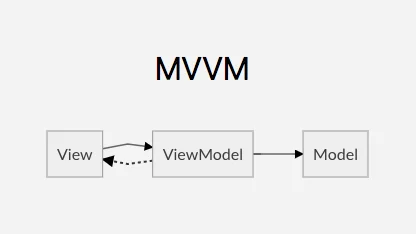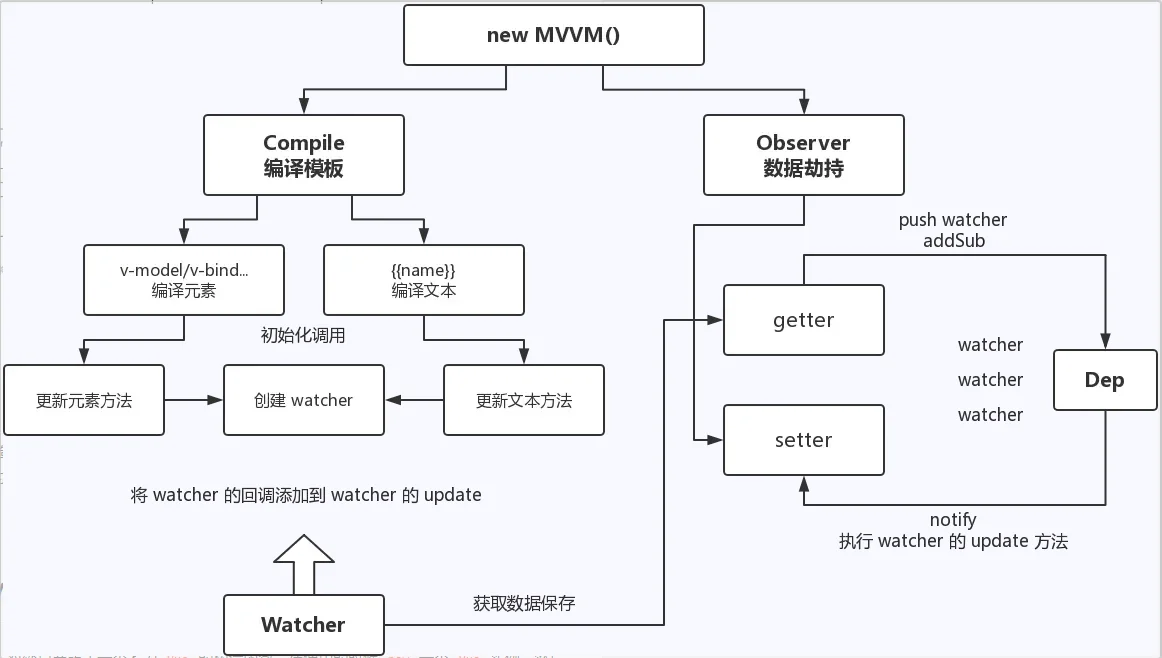demo在线地址: https://codesandbox.io/embed/like-vue-qs42n?fontsize=14&hidenavigation=1&theme=dark

分析
1
2
3
4
5
6
7
8
9
10
11
12
13
14
15
16
17
18
19
| let vm = new Vue({
el: "#app",
data: {
msg: " 改变",
obj: {
title: "<strong>仿写vue</strong>",
o: {
name: "asdasdas"
}
}
},
methods: {
handle() {
console.log(this);
alert(123);
this.msg = "shijiangaibiancanshu1";
}
}
});
|
调用vue就是实例化一个Vue类的过程, vue的各个api继承自Vue类,option通过参数传入, 由于es5代码会比较啰嗦,采用es6方式, el是作用域的根节点,可以传入选择器或者element节点, data是响应的数据也是比较核心的部分,
可以看到首先判断元素绑定是否成功,除去数据代理先不讲,程序主要执行两个步骤,分别处理模版和数据:
- new Observer: 将整个数据data传入
- new Compile: 将根元素el传入
1
2
3
4
5
6
7
8
9
10
11
12
13
14
15
16
17
18
19
20
21
22
23
24
25
26
27
28
29
| class Vue {
constructor(options) {
this.el = options.el;
this.data = options.data;
this.methods = options.methods;
if (this.el) {
new Observer(this.data);
this.proxy(this.data, this);
new Compile(this.el, this);
}
}
proxy(data, vm) {
Object.keys(data).forEach(key => {
Object.defineProperty(vm, key, {
get() {
return data[key];
},
set(newVal) {
data[key] = newVal;
}
});
});
}
}
|
一个最基本的MVVM框架需要实现这几个模块: 数据劫持(observer), 模版编译(compile), 依赖收集(dep), 发布订阅(watcher,又称观察者), 代码都是比较常用的那类,难点在于设计模式的精巧和抽象,下面的图片,需要好好的理解

右边部分我的理解大致是这样的: 在实例化时将数据传入类的内部,检测传参是否为对象,遍历传参对象的属性并递归嵌套对象,然后处理数据,关键api是es6的Object.defineProperty文档参考,简单理解就是自定义对象属性,并通过getter和setter这个钩子进行我们的数据观察,(大喊一声:这里先占一个坑!)
在每一次遍历数据,劫持前,实例化一个依赖收集器, 该收集器具有添加观察者(watcher)存储,和通知更新两个方法,
在劫持数据的getter时收集器执行添加watcher, 在数据发生setter时,收集器通知更新
watcher
watcher类主要功能接收一个回调,和获取对象数据的新旧值比对,在发生改变的时候,触发回调的执行
模版编译compile
模版编译是将根元素下的所有节点转换为文档片段createDocumentFragment提高性能,再插入根节点渲染,遍历文档片段下的每一个节点的nodeTye,区分是元素节点(如果是元素节点可能存在嵌套,递归处理)还是文本节点,拆分两种处理函数..
源码:
1
2
3
4
5
6
7
8
9
10
11
12
13
14
15
16
17
18
19
20
21
22
23
24
25
26
27
28
29
30
31
32
33
34
35
36
37
38
39
40
41
42
43
44
45
46
47
48
49
50
51
52
53
54
55
56
57
58
59
60
61
62
63
64
65
66
67
| class Compile {
constructor(el, vm) {
this.el = this.isElement(el) ? el : document.querySelector(el);
this.vm = vm;
let fragment = this.node2Fragment(this.el);
this.compile(fragment);
this.el.appendChild(fragment);
}
isElement(el) {
return el.nodeType === 1;
}
node2Fragment(el) {
let f = document.createDocumentFragment();
let firstChild;
while ((firstChild = el.firstChild)) {
f.appendChild(firstChild);
}
return f;
}
compile(fragment) {
let nodes = fragment.childNodes;
[...nodes].forEach(node => {
if (this.isElement(node)) {
this.compileElement(node);
this.compile(node);
} else {
this.compileText(node);
}
});
}
compileElement(node) {
let attributes = node.attributes;
[...attributes].forEach(attr => {
let { name, value } = attr;
if (this.isDirective(name)) {
let [, directive] = name.split("-");
let [dirName, eventName] = directive.split(":");
// console.log(name, value, directive);
compileUtil[dirName](node, value, this.vm, eventName);
node.removeAttribute(`v-${directive}`);
} else if (this.isEvent(name)) {
let [, eventName] = name.split(":");
compileUtil["on"](node, value, this.vm, eventName);
}
});
}
compileText(node) {
let textContent = node.textContent;
if (/\{\{(.+?)\}\}/.test(textContent)) {
compileUtil["text"](node, textContent, this.vm);
}
}
isDirective(name) {
return name.startsWith("v-");
}
isEvent(name) {
return name.startsWith("@");
}
}
|
原创手打,留言支持一下吧~



